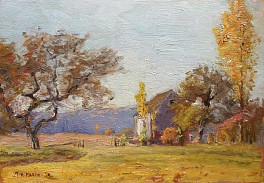BIOGRAPHY

1864-1949
MAHLON HENRY MARLIN
(1864-1949)
Mahlon Henry (M. Harry) Marlin was born in the Poquonnock section of Windsor, Connecticut in 1864. His father, John Mahlon Marlin, was a mechanic (machinist) at Colt Patent Fire-Arms in Hartford. In 1870, John Marlin relocated his small family to New Haven, where he opened his own gun manufactory on State Street. The older Marlin's first successes were the rifle models 1891 and 1893, later produced by Marlin as the Model 39 and 336. He also produced a range of revolvers, pistols and derringers from 1870 to 1899.
At that time, John Marlin's biggest competitor was Oliver Winchester, who bought New Haven Arms in 1866 and changed the name to Winchester Repeating Arms. Since that time, Winchester had been producing the "Yellow Boy," a lever-action rifle and Marlin wanted a piece of that market too. So in 1881, he trotted out the Model 1881 in the .45-70 Government caliber— used in the popular Springfield 1873 trapdoor-rifle. To strengthen the lever-action rifles, Marlin introduced a system to eject the cartridges to the side, instead of the top. Famous rifles from this era are the Marlin models 1891 and 1897, used by Annie Oakley and "'Buffalo Bill" Cody in their wild-west shows.
In 1901 John Marlin died, and his sons, Mahlon Henry (M. Harry) Marlin and John Howard Marlin, took over the business. After the start of World War I, the sporting arms business underwent a huge change. M. Harry loved producing the hunting rifles for which Marlin had become famous, but if the firm was to survive, it had to gear up for the production of military rifles. This didn't interest him, so he decided to sell. In 1915, Marlin Firearms was sold to a New York syndicate for $1.5 million and renamed Marlin Rockwell. After the sale, M. Harry Marlin, 52, and John H. Marlin, 39, retired. (In 1924, Atty. Frank Kenna bought Marlin Firearms from Rockwell at auction for $100 dollars— plus the assumption of $100,000 in debt. The Kenna family has owned the company ever since.)
After his retirement from the firearms business, M. Harry Marlin devoted all of his time to oil painting. It was said that while he worked at Marlin, he had no time for hobbies, completely absorbed in business matters and the design of new rifles. Now, he devoted that same energy to painting. It is a great tribute to Marlin that, during the last 34 years of his life, he became such a fine painter that his works are included in Davenport's, the Artists Bluebook and many other reference works. It is also a fascinating curiosity that, even though Marlin lived in one of the most exclusive neighborhoods in New Haven—his Townsend Avenue home was valued at $50,000 in 1930, about ten times the cost of a starter home—had many servants and never any serious financial concerns, he still painted on wooden supports of his own manufacture rather than buy canvases from local art dealers.
M. Harry Marlin died at home in 1949 at the age of eighty-five.
The above information, submitted by Kevin Murphy, was supplied by the US census reports, reference librarian Jill Adams at the Connecticut Historical Society and Marlin Firearms: A History of the Guns and the Company That Made Them by William S. Brophy (1989). From the archives of AskArt.
